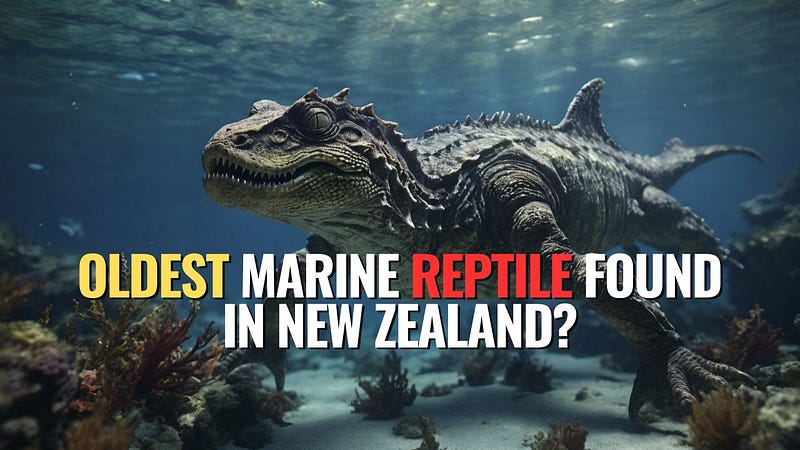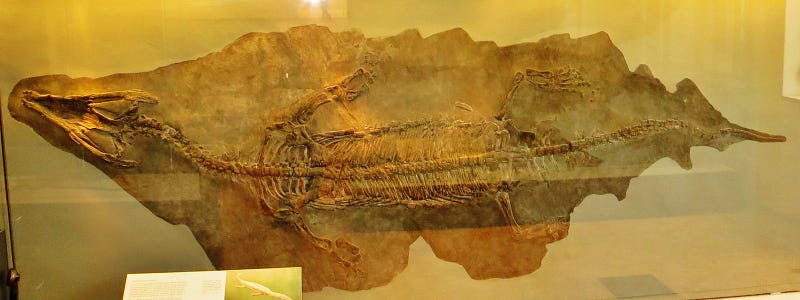# Discovery of the Oldest Known Marine Reptile in New Zealand
Written on
Chapter 1: Introduction to the Nothosaur
A singular vertebra has been preserved, leading scientists to confirm it as the oldest known marine reptile from the Southern Hemisphere—a nothosaur that roamed the Earth at the dawn of the dinosaur era.

During the early age of dinosaurs, approximately 246 million years ago, New Zealand was situated in the polar region of the expansive Panthalassa Ocean. This is the time period from which the newly identified ancient reptile originates. Nothosaurs were expertly adapted for aquatic life while also spending time on land, much like modern seals. They had sleek bodies, limbs ending in five fingers with webbing, and their front limbs were shorter than their hind limbs. Equipped with flattened skulls and slender, conical teeth, nothosaurs primarily fed on fish and squid, averaging 2 to 3 meters in length.
The New Zealand Nothosaur: A Historical Find
The fossilized remains of this nothosaur were unearthed during geological studies in 1978. However, it often takes years for scientists to thoroughly analyze and understand the implications of fossil discoveries. The vertebra was retrieved from a boulder situated in a streambed at the base of Mount Harper on New Zealand's South Island. Recently, a collaborative team of paleontologists from Sweden, Norway, New Zealand, Australia, and East Timor published their findings in the journal "Current Biology."
Dr. Benjamin Kear from the Museum of Evolution at Uppsala University, the lead author of the study, states, "The nothosaur found in New Zealand predates the previously oldest known sauropterygian fossils from the Southern Hemisphere by over 40 million years." These ancient marine reptiles thrived in shallow, biodiverse coastal waters within the southern polar circle.
Chapter 2: The Origins and Migration of Nothosaurs
The earliest nothosaur fossils date back about 248 million years and were discovered in the northern low-latitude belt, stretching across the vast superocean Panthalassa. The questions surrounding the origin, spread, and timing of nothosaur migration to remote polar areas remain open for discussion. Some hypotheses suggest they migrated along northern polar coasts or traversed through inland sea routes, possibly utilizing ocean currents for long-distance travel.
Dr. Kear explains, "Through a time-calibrated evolutionary model of global sauropterygian distribution, we demonstrate that nothosaurs originated near the equator and quickly spread north and south concurrently, as complex marine ecosystems began to recover following the mass extinction that heralded the age of dinosaurs."

Evolution of Marine Reptiles
Reptiles began to adapt to aquatic environments following the Permian mass extinction, which occurred roughly 245-252 million years ago. This catastrophic event devastated marine ecosystems and paved the way for the rise of dinosaurs. Evidence of this evolutionary transition has been uncovered in various locations, including the Arctic island of Spitsbergen, northwestern North America, and southwestern China. The recent New Zealand discovery adds to this evolving narrative and enhances our understanding of early marine reptiles from the Southern Hemisphere.
For millions of years, reptiles dominated the oceans, with the sauropterygians being the most diverse and long-lived group, boasting an evolutionary lineage that spans over 180 million years. Besides nothosaurs, this category also included plesiosaurs, characterized by their elongated necks. Often depicted as the legendary creature of Loch Ness, plesiosaurs could grow up to 7 meters in length and swam using four paddle-like limbs.
Dr. Kear adds, "The onset of the dinosaur era was marked by significant global warming, which enabled these marine reptiles to prosper at the South Pole. This indicates that ancient polar regions likely served as pathways for their initial migrations."
Conclusion: The Significance of Discovery
The discovery of this nothosaur provides crucial insights into the fossil record of early marine reptiles and their migratory patterns. As we continue to unearth more about these fascinating creatures, we gain a deeper understanding of the complexities of life in our planet's prehistoric oceans.
Support for Content Creation
If you appreciate the value of quality content, consider supporting creators on platforms like Medium.com. Small contributions can significantly impact the ongoing effort to produce informative articles.

